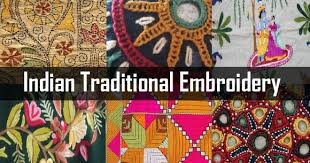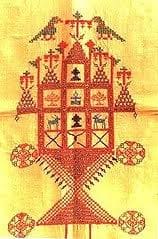Embroidery is an art of decorating cloth with needlework using different types of threats to create fascinating designs. Embroidery can also be defined as an art of using stitches as an adorning feature by embellishing fabric or other material with designs, stitches in strands of threads on yarn using a needle. Embroidery may also include other materials like pearls, beads, sequins, etc. Embroidery is a craft of enhancing fabric with motifs, abstract design, patterns. Embroidery varies according to its underlying foundation fabric and whether the design is stitched on the top or through the base fabric.
Indian embroidery includes a wide variety of regional embroidery styles varying by different regions and materials used. Embroidery is India’s persistent eloquent tradition. Every state and region in India enjoys its own style. Needlework is not the only means of decorating the fabric but the fabrics are also embellished by stories of the community, with motifs emerging from natural surroundings, religious inscriptions, economic state, etc.
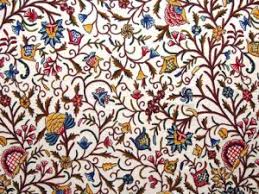
Hand Embroidery
Handmade items are recaptured as new personification and the manifestation of luxury. Many ancient embroidery styles are being reclaimed and popularised. These embroidery styles are not only gaining its acceptance among the Indian designers but are also very popular with the International labels. Mumbai is a trade hub for many luxury brands chasing Indian embroidery. A brand like Gucci, Valentino, Maison Margiela, Christian Dior have collaborated with Chanakya, a Mumbai-based embroidery firm. Brands like Roberto Cavalli, Salvatore Ferragamo, Versace, Michael Kors are in partnership with Aditya Designs, another Mumbai-based embroidery firm.
TYPES OF INDIAN EMBROIDERY
Some acclaimed and renowned Indian embroideries
Kashida (Kashmir)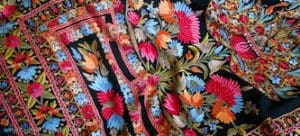
Kashida is a popular Kashmiri embroidery encouraged by the beautiful surroundings of the valley. This type of embroidery style is practiced by men in the region. In the 15th century, the Sultan- Zain-ul-Abidin introduced the art of Kashidakari. Weavers were brought from Turkistan and Persia to introduce new styles of weaving techniques. This type of embroidery is very popular because of its color texture design and techniques. The motifs in Kashida are inspired by nature including both flora and fauna of Kashmir. The most common themes of Kashida embroidery are birds like Kingfisher, butterflies; fruits and 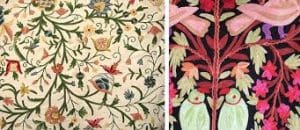 vegetables like mango, almonds, cherry, grapes; and flowers like lotus, blossoms, creepers, maple leaves. The best material for the embroidery is wool, Cotswold, or silk wool and Cotton. Embroidery is often evident on shades of white and light shades and sometimes they are also on pastel colors but nowadays they are using a variety of colors like blue, yellow, purple, red, green, black. Kashida embroidery is particularly practiced by men and is a commercial craft revealed on shawls as well as in cottage industries of Srinagar. The stitches used in Kashida embroidery includes Satin Stitch, Chain Stitch, Stem Stitch, Talibar, Vatachik, Darning Stitch. Embroidery is performed using cotton, silk, wool, and artificial silk threads of white, green, yellow, purple, blue, black, crimson, and scarlet colors.
vegetables like mango, almonds, cherry, grapes; and flowers like lotus, blossoms, creepers, maple leaves. The best material for the embroidery is wool, Cotswold, or silk wool and Cotton. Embroidery is often evident on shades of white and light shades and sometimes they are also on pastel colors but nowadays they are using a variety of colors like blue, yellow, purple, red, green, black. Kashida embroidery is particularly practiced by men and is a commercial craft revealed on shawls as well as in cottage industries of Srinagar. The stitches used in Kashida embroidery includes Satin Stitch, Chain Stitch, Stem Stitch, Talibar, Vatachik, Darning Stitch. Embroidery is performed using cotton, silk, wool, and artificial silk threads of white, green, yellow, purple, blue, black, crimson, and scarlet colors.
The fascinating feature of the embroidery is that it is made of single thread offering a flat appearance to the design. This embroidery enhances the grace of Kashmiri shawl, saris, and other dress materials.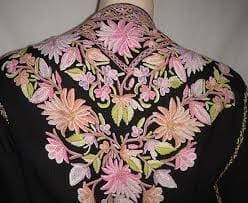
Chikankari (Uttar Pradesh)
The word chikankari is coined from Persian word Chakeen that means elegant patterns on the fabric. This type of embroidery is famous in the state of Uttar Pradesh especially the city of Lucknow known as a hub of chikankari embroidery. Chikankari embroidery is also known as a Shadow Work by using herringbone stitch from the wrong side of the fabric to create the shadow on the right side, imparting an outline for Motif. Chikankari embroidery is also popularized as White embroidery. Traditionally the chikankari embroidery was exclusively done on white muslin fabric using white thread. Nowadays it has been done on various types of fabrics like linen, nylon, georgette, cotton, chiffon, and also synthetic fabrics. This type of embroidery is also done on various household things like curtains, bedsheets, pillow covers, cushion covers, table cloths. Contradicting to ancient times chikankari embroidery is done on various pastel color fabrics but using white color thread. The motifs are stimulated from natural flora including jasmine, rose, peacock, parrot, and lace patterns.
The patterns of printed from the woodblocks in washable colors. The designs are stamped 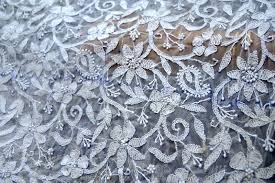 on the cloth and passed on to the embroiderers. Chikankari uses stitches like Satin Stitch, Stem Stitch, Back-Stich, Herring Bone Stitch, Button-Hole Stitch.
on the cloth and passed on to the embroiderers. Chikankari uses stitches like Satin Stitch, Stem Stitch, Back-Stich, Herring Bone Stitch, Button-Hole Stitch.
The chikankari work is of two types- flat style and knotted embossed. Chikankari work is done on a sari, blouse, kurta, sari borders, and above-mentioned household linens.
Kantha (Bengal)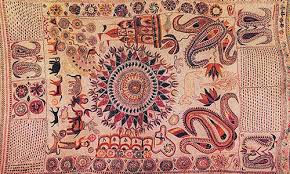
Kantha in Sanskrit means rags. It is a traditional artist Bengal which means Patched Cloth. There are several mythologies associated with the origin of this art form. It was said that in ancient times, the women used to pile up the layers of torn clothes and stitch them. Lord Buddha is also associated with the origin of this art because Lord Buddha and his disciples used thrown away rags to cover themselves. Kantha is a Sanskrit word meaning throat and Lord Shiva has been named Nilakanth meaning blue throat and it is also known as Throat Chakra.
This type of embroidery is done on discarded comments like layers of dhoti, sari stitched together with simple running stitch in the white thread that provides protection from the cold. The Muslin sari of Grey, black or white colors are the elegant and beautiful illustration of Handloom Textiles are considered valuable by the women folk of Bengal.
There are two categories of Kantha embroidery – in the first type, cotton saris or dhotis are piled up on top of each other, quilted, and embroidered. The other type used discarded cotton bedspreads and pictorial embroidery was done with the Tussar Silk threads. Motifs used for this embroidery include Lotus, Solar, Moon, Wheel, Swastik, Kalka, Tree Of Life. Kantha embroidery is done on the old fabrics and the threads used for embroidery are drawn from the colorful borders of the discarded saris main the white, red, green, yellow, blue, and black in color. The stitches used in Kantha embroidery are satin, loop, running, and darning stitch.
Phulkari (Punjab)
Phulkari embroidery started in the 15th century and continues till today. Phulkari is a Punjabi rural tradition of handmade work derived from two Sanskrit word phul means flower and Kari mean work. Phulkari means the flower craft, floral work in which the entire surface of the shawl is decorated with floral designs. Phulkari and Bagh were the traditional embroidery shawls from rural Punjab. The word Phulkari is common in East Punjab and Bagh is a popular word for shawls in west Punjab. Phulkari is a shawl that is designed as embroidery to cover women’s heads to be displayed in a Gurdwara. Phulkari is an integral part of the life of Punjabi girl and is considered to be opportune, symbolizing happiness prosperity, and Suhaag of a married woman.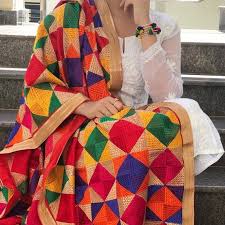
Originally Phulkari embroidery was done on back covers but nowadays it is also done on cushion covers, bolster covers and saris. The Phulkari embroidery is done on The Wrong side with the threads of floss silk called Pat. Pat is red, white, golden, green, blue, purple, and orange in color. Nowadays cotton blended threads and rayon floss are also used. The motifs are made of horizontal, vertical, and diagonal stitching producing geometrical patterns like square, rectangle, vertical, and horizontal lines.
Zari Work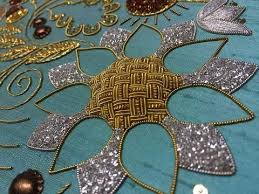
Zari is also known as Zardosi embroidery. This type of embroidery exists in India from the time of Rigveda. Zardozi is a combination of two Persian terms zari means gold and dozi means embroidery. Zari embroidery is done using gold and silver thread for embroidery work. Surat and Varanasi at the Paramount centers for making the metal thread known as Kalabathi. This embroidery prosper during the Mughal period and was done on silk. It involves preparing complex designs using gold and silver threads and studded pearls and precious stones and magnificence to the work.
There are two main types of embroidery Zardosi is the heavy embroidery and Kamdani is the lighter one. Nowadays it is done on Satin with buckram lining. The stitches used in embroidery are satin, running, couching, and lain stem.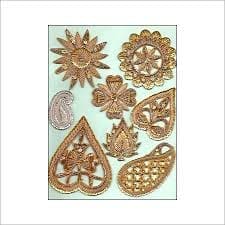
The Zari embroidery has 5 major designs with further variations. They are
- Jali which comprises of geometrical pattern
- Bharat designs are the filling work
- Floral designs with motifs of flowers and creepers.
- Birds with panchi motif
- Animal motifs
The popular styles practice all over India in Zari embroidery are
- Salma Sitara which uses small round pieces of gold and silver in between the Zari work
- Kamdani in which thousands of thoughts produce a glittering effect and the design is known as Hazari Butti
- Minakari using a gold coating
- Mokaish did with silver thread
- Gota in which the borders are made up of gold and silver threads.
Kasuti (Karnataka)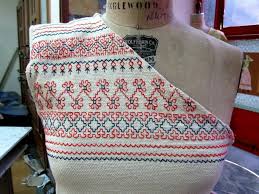
Kasuti is a traditional folk embroidery of Karnataka state and is an art form of women. Kasuti embroidery symbolizes the traditions, customs, and profession of Karnataka people. The word Kasuti is derived from word Kai means hand and Suti means cotton thread. Thus Kasuti is the handwork of cotton thread. It was a custom in ancient times start the bride has to own a black silk saree called Chandrakali Saree with Kasuti work. Kasuti work is done on five garments- Kunchi (bonnet and cape combined), lehanga (skirt), seragu (pallav of a sari), kusuba (bodice), and kulai (bonnet).
The motifs used in kasuti embroidery varied between mycological and architectural to flora and fauna. The motifs used in kasuti are inspired from-
- Temple architecture: gopurams of South India, raths and palanquins

- Bird motifs like peacock, swan, squirrel, parrot,
- Animal motifs include sacred Bull Nandi, elephant, and deer.
- Kasuti embroidery inspired from articles of daily use like rudraksha, flower pot, anklets, bells, chess square, cradle.
The fabric used for kasuti embroidery is Khans (used as blouse pieces) and Irkal saris. Nowadays, Kasauti embroidery is done on any type of fabric. The kasuti embroidery is done by orange, green, purple, red colors and white is prominent on the black and dark background.
Chamba Rumal ( Himachal Pradesh)
Chamba rumals are the exceptional and wonderful work of embroidery depicting a delicate fine and flawless work called needle miniatures of Himachal or Pahari Rumal. The primeval Chamba has undergone a progression with respect to motifs, stitches, workmanship, appearance, and colors. Colors employed in this type of embroidery are very vibrant bright and bold. The Chamba Rumal had unique importance as embroidery women are used for covering gifts, deities, household accessories such as caps, hand fans, pillow covers, wall hanging, ceiling covers, and blouse piece.
There are two different kinds of Chamba rumals one in the style of Pahari paintings and the other one is a folk style used by women to embroidery their choli and rumals using their own designs. The thread used for embroidery is a Silk thread that gives a unique effect against a dull cotton background. The Chamba Rumal is a combination of infinite vibrant and contrasting colors like red, yellow, green, blue, crimson, and purple. The folk style uses bright colors including pink, lemon while the sophisticated color palette includes pale shades like dark green, blue, ochre.
Embroidery is done using a double Satin stitch called Dorukha. Stem stitch is used to draw the outlines and Gujjar women used darning, herringbone, and sometimes satin stitch. Chamba embroidery is inspired by immortal classics like Mahabharat, Ramayan, themes from Indian mythology, a game of chaupad, hunting and marriage scenes, and even the episodes from Raasleela of Radha and Krishna. Sometimes the embroidery also consists of floral and geometrical designs and the border designs are generally floral.
The motive used are
- Animals like leaping tiger, prancing horses, running boars
- Birds like swans, ducks, peacocks
- Trees include willow tree, plantain tree, cypress tree
- Musical instruments like flute, veena, sitar
- Muslim Gujjar women use geometrical designs like triangles, diamond, hexagonal, and circle.
Article Written By-
Naina Rupani, Management Trainee- TVC
FOSTIIMA Business School
navyarupani09@gmail.com

